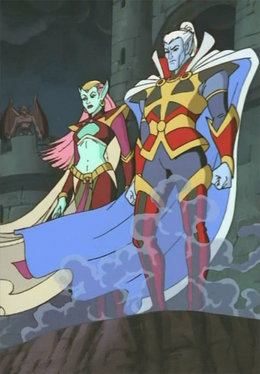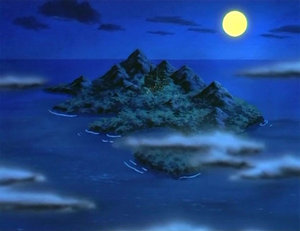Avalon
- For the episode of the same name, see Avalon (episode)
Avalon is the island home of Oberon's Children.
Contents
History
Avalon was formed at about the same time that the Third Race were, from magic. It was ruled over first by Queen Mab, then following her overthrow, by her son Oberon, who still rules there today. [1]
In the early 6th century, the wounded King Arthur Pendragon was admitted to Avalon for healing, and placed in an enchanted sleep within the Hollow Hill. Oberon, while disliking the presence of mortals on his island, permitted this because he owed Merlin a favor. [2]
In 995, Oberon, angered at his Children's scorn and contempt for mortals, and particularly that displayed by Titania, banished the entire Third Race from Avalon for a thousand years, leaving the Weird Sisters behind to bar the entrance on a floating barge nearby. Shortly afterwards, Princess Katharine, the Magus, and Tom fled to Avalon with the eggs following Constantine III's usurpation of the Scottish throne. After the Magus defeated the Weird Sisters, the three refugees settled on Avalon with the eggs, and lived there contentedly (more or less) for the next thousand years. ("Avalon Part One")
In 1995, the Archmage decided to conquer Avalon, to use it as his base of operations for waging war upon the human world. He joined forces with the Weird Sisters, Demona, and Macbeth to attack the Avalon Clan and destroy it. The Avalon clan, aided by Goliath, Elisa, Bronx, and King Arthur (whom Elisa awakened from his sleep), defended its home against the evil sorcerer and his followers, and finally won. ("Avalon Part Two", "Avalon Part Three")
Not long afterwards, Oberon and Titania returned to Avalon, and learned about the Avalon clan from the Weird Sisters. Oberon wanted to banish them from the island, but the Avalon clan created an iron bell and used it to defeat him, after which Princess Katharine persuaded him to let them stay. Oberon not only granted them permission to do so, but even made the Avalon gargoyles his guard of honor (a largely ceremonial role, but one Oberon does consider to be of value). ("Ill Met By Moonlight") [3] Afterwards, he held the Gathering, bringing home all of the Third Race (except for Puck, in the end); currently, the Fair Folk are assembled upon Avalon. ("The Gathering Part One")
Characteristics
Avalon cannot be found on a map of the world; it is reachable only by magic. Despite being part of the Earth, its true location is found at a rather large nexus of native Earth magic, and therefore is incapable of being reached in a three dimensional manner. [4][5] Mortals do not necessarily need a vessel to travel to and from Avalon. [6][7] The usual procedure for entering Avalon for mortals is to recite the following Latin incantation while upon a body of water (which can range in size from the sea to a large washbasin):
- Vocate venti fortunate,
- ex ricae Oberonis,
- et hic navis frugum regate,
- ad orae Avalonis [8]
Oberon's Children, on the other hand, can presumably come and go through their innate abilities, without needing water nearby. Leaving Avalon is somewhat trickier; it does not send you to where you wish to go, but to where you need to be (hence the Avalon World Tour that Goliath, Elisa, Angela, and Bronx involuntarily embarked upon after leaving the enchanted island). ("Avalon Part Three")
Avalon is, in a sense, solidified magic, and an experienced human wizard can actually tap into that magic, as the Magus did during his battle with the Weird Sisters; it is not easy to do, however, and even cost the Magus his life. While faerie magic is permitted in Avalon, human magic (particularly that coming from artifacts such as the Grimorum Arcanorum) is not. (The Archmage did temporarily evade this proscription by eating the Grimorum, but he paid a fatal price for it in the end.) It is unclear how the human magic involved in reviving the Coldtrio would affect their access to the island. ("Avalon Part Two") [9]
When traveling to and from Avalon, the island magically compensates by preventing its travelers from feeling the effects similar to that of jet lag. [10] The island also assists by allowing its travelers to understand any native languages, dependent on who they are meant to interact with. This latter magical compensation appears to be permanent for individuals like King Arthur Pendragon and Angela, who both now speak modern English. [11][12]
Because of its magical nature, time passes slower on Avalon; for every hour spent there, one day goes by in the outside world (or in other words, 24 times slower then normal time). It is also eternal summer there (by Oberon's decree), and prior to leaving Angela claimed she had never seen ice or snow. [13] During Queen Mab's reign, however, the climate on Avalon was better described as "chaotic". ("Avalon Part One", "Shadows of the Past", "Eye of the Storm") [14]
Given that time passes slower on Avalon, it remains uncertain how this effects the appearance and frequency of the Moon's monthly phasing (assuming it waxes and wanes at all from Avalon's point of view). [15] The constellations in the night sky are believed to be seen from a position unique from that of any other place on Earth. [16] The island is largely incapable of receiving any radio signals from the outside world. [17]
Avalon has a few important landmarks: the palace where Oberon and Titania live (which is also the home for the Avalon Clan), the Hollow Hill where King Arthur slept (and where the Magus has now been laid to rest), a volcano, and grotto which served as the Archmage's headquarters during his invasion of Avalon. An apple orchard stands in the palace grounds. The apples are believed to be native to the island. [18] Jade and Turquesa have also transplanted various rare plants brought from Guatemala (which are said to be flourishing). ("The Green") [19] Some forms of fauna might also inhabit Avalon, with the possibility that the magical environment might have effected them to some small degree. [20]
The relationship between Avalon and Oberon is uncertain. On the one hand, Oberon can command the island to do his bidding, ordering even the rocks to throw themselves at intruders. On the other hand, Avalon sent Goliath and his companions to Manhattan at the end of the World Tour to foil Oberon's plan to abduct the infant Alexander. ("Ill Met By Moonlight", "The Gathering Part One")
The water immediately surrounding the island is said to be a mix of both fresh and salt water. [21]
Time differential
On Avalon:
- One day equals 24 days in the outside world
- 30 days equals 720 days (or nearly two years)
- One year equals 24 years
- 41.6 years equals 1,000 years
- 100 years equals 2,400 years
Appearances
- "Avalon Part One" (Mentioned Only)
- "Avalon Part Two"
- "Avalon Part Three"
- "Shadows of the Past" (Mentioned Only)
- "Heritage" (Mentioned Only)
- "Monsters" (Mentioned Only)
- "Sanctuary" (Mentioned Only)
- "The Hound of Ulster (Mentioned Only)
- "Walkabout" (Mentioned Only)
- "Mark of the Panther (Mentioned Only)
- "Pendragon" (Mentioned Only)
- "Eye of the Storm" (Mentioned Only)
- "The New Olympians" (Mentioned Only)
- "The Green" (Mentioned Only)
- "Bushido" (Mentioned Only)
- "Cloud Fathers" (Mentioned Only)
- "Ill Met By Moonlight"
- "Future Tense" (Mentioned Only)
- "The Gathering Part One"
- "The Gathering Part Two" (Mentioned Only)
- "Turf" (Mentioned Only)
- "The Reckoning" (Mentioned Only)
- "Possession" (Mentioned Only)
- "Reunion" (Mentioned Only)
- "The Gate" (Mentioned Only)
- "Phoenix" (Mentioned Only)
Real World Background
Avalon emerges in Arthurian legend as a mysterious enchanted island, associated with the faerie-folk, to which King Arthur was taken after his final battle at Camlann. Its earliest known mention comes from Geoffrey of Monmouth in his History of the Kings of Britain, where it is mentioned as being the place where Excalibur was forged, and to which Arthur was taken after his final battle. In his The Life of Merlin, a sort of sequel to his better-known History, he gives a more detailed description of Avalon as a magical island, to which Merlin and the legendary Welsh bard Taliesin took the wounded Arthur, where Morgan le Fay - portrayed here as a benevolent figure - received him and tended him.
Avalon seems to have developed from the legends about paradisaical islands in Celtic mythology; it is worth noting that the Welsh form of its name is "Ynys Avallach" or "The Isle of Avallach", Avallach being a mysterious otherworldly figure in Welsh myth, portrayed as Morgan le Fay's father. However, its name also seems to be derived from "apple", fitting in with the fact that apples were commonly found in the magical islands of Celtic myth. The Avalon of Gargoyles likewise contains an apple orchard in the grounds of Oberon’s palace.
While the Arthurian legends often interpreted Avalon in much the same light that Gargoyles did, as a remote enchanted island, a different view of Avalon emerged in 1190, at Glastonbury Abbey in Somerset. Some of the monks of Glastonbury reported discovering the grave of King Arthur within the Abbey, marked by a lead cross which described Arthur as being buried in "the Isle of Avalon". This suggested that Avalon was merely an old-fashioned name for Glastonbury and not a magical island after all. This possibility was assisted by the fact that Glastonbury was a marshy region in the Dark Ages and could have been an island at one point, and that it does have a reputation for otherworldliness. In the Gargoyles Universe, however, Avalon and Glastonbury are clearly not identical.
After this discovery of "Arthur's tomb" (historians and archaeologists remain divided as to how genuine this discovery actually was), a different trend concerning Arthur's fate emerges in the writings about him; while some Arthurian romancers continued to claim that Arthur did not die but was taken away to Avalon, others, such as the anonymous author of the alliterative Morte Arthure, hold that he did indeed die and that Avalon and Glastonbury were one and the same. Sir Thomas Malory, in his Le Morte d'Arthur, was ambivalent, portraying Sir Bedivere discovering a tomb believed to be Arthur's at Glastonbury, but also stating that many people still believe that Arthur is not dead and will someday return (Malory himself did not believe this). Alfred Lord Tennyson, in his Idylls of the King, definitely held for the picture of Avalon as a magical island rather than a real-world locale, and had Arthur describe it in "The Passing of Arthur" as a place "Where falls not hail, or rain, or any snow,/ Nor ever wind blows loudly; but it lies/ Deep-meadow'd, happy, fair with orchard lawns/ And bowery hollows crown'd with summer sea". This description undoubtedly helped influence the depiction of Avalon in Gargoyles as a place of eternal summer - alongside the description of Celtic paradises in legend, which were sometimes even known as the "Summer Country" or the "Region of the Summer Stars".
Avalon's different time scale from the outside world also has roots in traditional legends about the faerie-folk. It was said about Faerie that time passed by much more slowly there, and that one could spend only a short time in that place and return to the human world to discover that years or even centuries had gone by in the meantime. However, visitors to Faerie would generally age rapidly to match the passage of time in their absence from the mortal world, a fate which fortunately did not befall Angela or Tom when they left Avalon.
See Also
- Avalon at Wikipedia, the Free Encyclopedia


